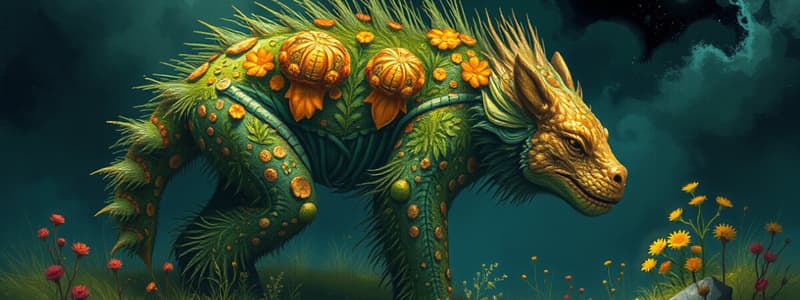Podcast
Questions and Answers
Which species is cited as a classic example of a keystone species that acts as an ecosystem engineer?
Which species is cited as a classic example of a keystone species that acts as an ecosystem engineer?
- Red-tailed hawk
- North American beaver (correct)
- Eastern grey squirrel
- North American wolf
What role do mycorrhizal fungi play in forest ecosystems?
What role do mycorrhizal fungi play in forest ecosystems?
- They primarily compete with trees for sunlight.
- They inhibit the growth of tree species.
- They enhance the tree’s ability to absorb soil nutrients. (correct)
- They extract nutrients from trees for their own survival.
What can be the result of introducing an exotic species to a community?
What can be the result of introducing an exotic species to a community?
- Creating new food sources for native species.
- Promoting the growth of keystone species.
- Causing damage similar to the loss of a keystone species. (correct)
- Strengthening the ecosystem through biodiversity.
Why are keystone species crucial for ecosystem health?
Why are keystone species crucial for ecosystem health?
How can the loss of a keystone species affect a forest community?
How can the loss of a keystone species affect a forest community?
What defines a keystone species in a community?
What defines a keystone species in a community?
Which of the following is an example of a keystone species as described in the content?
Which of the following is an example of a keystone species as described in the content?
What outcome occurred when Pisaster was removed from the intertidal community?
What outcome occurred when Pisaster was removed from the intertidal community?
In the context of keystone species, what role can figs and nectar play in tropical forests?
In the context of keystone species, what role can figs and nectar play in tropical forests?
What characteristic distinguishes keystone pollinators from more abundant ones?
What characteristic distinguishes keystone pollinators from more abundant ones?
What is a consequence of the hunting of Old World fruit bats in the South Pacific?
What is a consequence of the hunting of Old World fruit bats in the South Pacific?
Which factor would disqualify a species from being a keystone species?
Which factor would disqualify a species from being a keystone species?
Which of the following statements about keystone species is incorrect?
Which of the following statements about keystone species is incorrect?
Flashcards are hidden until you start studying
Study Notes
Keystone Species Overview
- A keystone species has a disproportionately large impact on its ecosystem relative to its abundance.
- These species can influence community structure and biodiversity despite being less numerous.
Importance of Keystone Species
- Removal of a rare keystone species can result in unexpected ecological shifts and loss of biodiversity.
- Unlike abundant species, keystone species maintain balance among various populations.
Example: Pisaster and Mytilus
- The sea star Pisaster serves as a key predator in a Pacific intertidal community.
- Removal of Pisaster leads to unchecked population growth of mussels (Mytilus), causing competition with other species and subsequent loss of eight species.
Keystone Food Sources in Tropical Forests
- Figs, nectar, and specific fruits constitute less than 1% of plant diversity in Central and South American tropical forests but act as critical food sources.
- During periods of low food availability, these keystone species support non-migratory herbivores.
Types of Keystone Species
- Keystone species can also function through mutualistic interactions:
- Irreplaceable Pollinators: Certain rare pollinators, like Old World fruit bats, are essential for plant reproduction and biodiversity on South Pacific islands.
- Habitat Modifiers: North American beavers, despite low biomass, reshape ecosystems by creating ponds that support diverse species.
- Mutualistic Species: Mycorrhizal fungi aid trees in nutrient absorption, critical for forest community health and resource availability.
Impact of Exotic Species
- Introduction of exotic species can mimic the effects of losing a keystone species, disrupting ecological balances.
- The extinction of a keystone species or presence of invasive species underscores a community's dependence on specific organisms for stability.
Studying That Suits You
Use AI to generate personalized quizzes and flashcards to suit your learning preferences.




